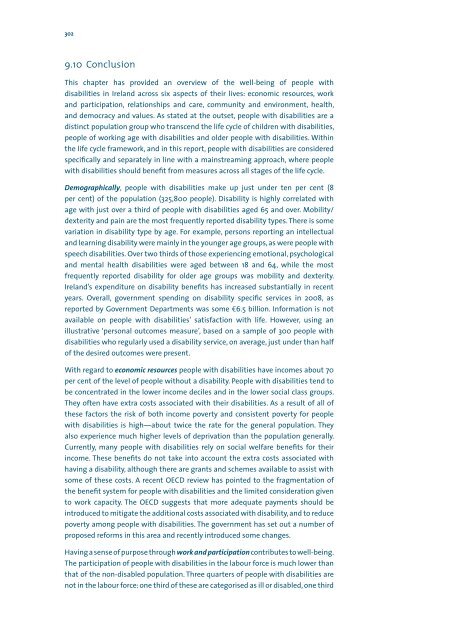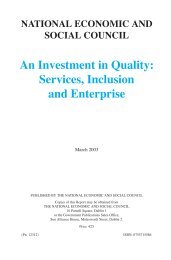A Social Report for Ireland Volume II - the NESC Website
A Social Report for Ireland Volume II - the NESC Website
A Social Report for Ireland Volume II - the NESC Website
Create successful ePaper yourself
Turn your PDF publications into a flip-book with our unique Google optimized e-Paper software.
3029.10 ConclusionThis chapter has provided an overview of <strong>the</strong> well-being of people withdisabilities in <strong>Ireland</strong> across six aspects of <strong>the</strong>ir lives: economic resources, workand participation, relationships and care, community and environment, health,and democracy and values. As stated at <strong>the</strong> outset, people with disabilities are adistinct population group who transcend <strong>the</strong> life cycle of children with disabilities,people of working age with disabilities and older people with disabilities. Within<strong>the</strong> life cycle framework, and in this report, people with disabilities are consideredspecifically and separately in line with a mainstreaming approach, where peoplewith disabilities should benefit from measures across all stages of <strong>the</strong> life cycle.Demographically, people with disabilities make up just under ten per cent (8per cent) of <strong>the</strong> population (325,800 people). Disability is highly correlated withage with just over a third of people with disabilities aged 65 and over. Mobility/dexterity and pain are <strong>the</strong> most frequently reported disability types. There is somevariation in disability type by age. For example, persons reporting an intellectualand learning disability were mainly in <strong>the</strong> younger age groups, as were people withspeech disabilities. Over two thirds of those experiencing emotional, psychologicaland mental health disabilities were aged between 18 and 64, while <strong>the</strong> mostfrequently reported disability <strong>for</strong> older age groups was mobility and dexterity.<strong>Ireland</strong>’s expenditure on disability benefits has increased substantially in recentyears. Overall, government spending on disability specific services in 2008, asreported by Government Departments was some c6.5 billion. In<strong>for</strong>mation is notavailable on people with disabilities’ satisfaction with life. However, using anillustrative ‘personal outcomes measure’, based on a sample of 300 people withdisabilities who regularly used a disability service, on average, just under than halfof <strong>the</strong> desired outcomes were present.With regard to economic resources people with disabilities have incomes about 70per cent of <strong>the</strong> level of people without a disability. People with disabilities tend tobe concentrated in <strong>the</strong> lower income deciles and in <strong>the</strong> lower social class groups.They often have extra costs associated with <strong>the</strong>ir disabilities. As a result of all of<strong>the</strong>se factors <strong>the</strong> risk of both income poverty and consistent poverty <strong>for</strong> peoplewith disabilities is high—about twice <strong>the</strong> rate <strong>for</strong> <strong>the</strong> general population. Theyalso experience much higher levels of deprivation than <strong>the</strong> population generally.Currently, many people with disabilities rely on social welfare benefits <strong>for</strong> <strong>the</strong>irincome. These benefits do not take into account <strong>the</strong> extra costs associated withhaving a disability, although <strong>the</strong>re are grants and schemes available to assist withsome of <strong>the</strong>se costs. A recent OECD review has pointed to <strong>the</strong> fragmentation of<strong>the</strong> benefit system <strong>for</strong> people with disabilities and <strong>the</strong> limited consideration givento work capacity. The OECD suggests that more adequate payments should beintroduced to mitigate <strong>the</strong> additional costs associated with disability, and to reducepoverty among people with disabilities. The government has set out a number ofproposed re<strong>for</strong>ms in this area and recently introduced some changes.Having a sense of purpose through work and participation contributes to well-being.The participation of people with disabilities in <strong>the</strong> labour <strong>for</strong>ce is much lower thanthat of <strong>the</strong> non-disabled population. Three quarters of people with disabilities arenot in <strong>the</strong> labour <strong>for</strong>ce: one third of <strong>the</strong>se are categorised as ill or disabled, one third
















